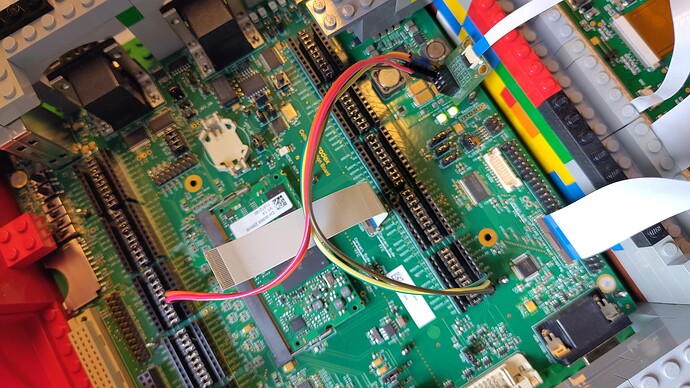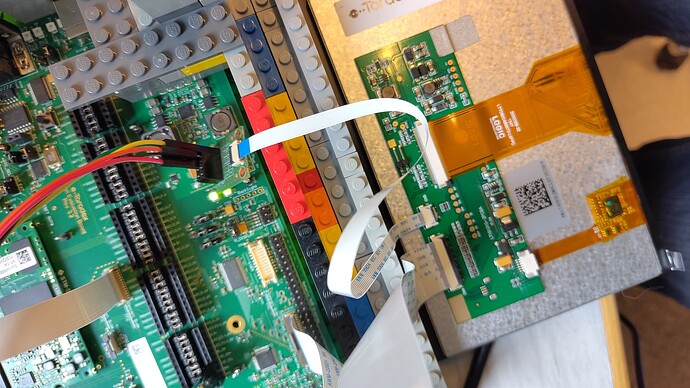Hi I have a Colibri Evaluation board with a 7’’ touch screen and cannot get the touch screen running. The display is working, but the touch functionality not.
The Display
[Capacitive Touch Display 7" Parallel | Toradex Developer Center]
The Adapter
[Capacitive Touch Adapter | Toradex Developer Center]
The Board
Rev. 3.2B
[Colibri Evaluation Board | Toradex Developer Center]
tdx-info
Software summary
------------------------------------------------------------
Bootloader: U-Boot
Kernel version: 6.1.84-6.6.1+git.347385861c50 #1-TorizonCore SMP Tue Jan 16 14:35:15 UTC 2024
Kernel command line: enable_wait_mode=off galcore.contiguousSize=50331648 root=LABEL=otaroot rootfstype=ext4 quiet logo.nologo vt.global_cursor_default=0 plymouth.ignore-serial-consoles splash fbcon=map:3 ostree=/ostree/boot.1/torizon/ea34e3589daba16d97d7d676f6ee759319a972778286ea5c64425a0e82920cb2/0
Distro name: NAME="TorizonCore Upstream"
Distro version: VERSION_ID=6.6.1-build.14
Distro variant: VARIANT="Docker"
Hostname: colibri-imx6-11372190
------------------------------------------------------------
Hardware info
------------------------------------------------------------
HW model: Toradex Colibri iMX6DL/S on Colibri Evaluation Board V3
Toradex version: 0077 V1.1A
Serial number: 11372190
Processor arch: armv7l
------------------------------------------------------------
overlays.txt
fdt_overlays=colibri-imx6_vga-640x480_overlay.dtbo colibri-imx6_panel-cap-touch-7inch_overlay.dtbo
According to [Touch Screen Calibration (Torizon) | Toradex Developer Center]
I tried starting the calibrator:
$ docker run -ti --rm --privileged -v /dev:/dev -v /run/udev/:/run/udev/ -v /etc/udev/rules.d:/etc/udev/rules.d torizon/weston-touch-calibrator:$CT_TAG_WESTON_TOUCH_CALIBRATOR
HEAD: DPI-1
Date: 2024-05-21 UTC
[14:52:30.042] weston 10.0.1
https://wayland.freedesktop.org
Bug reports to: https://gitlab.freedesktop.org/wayland/weston/issues/
Build: weston-10.0.1-1-8-g8a6fd0a
[14:52:30.060] Command line: weston -Bdrm-backend.so -Swayland-0
[14:52:30.060] OS: Linux, 6.1.84-6.6.1+git.347385861c50, #1-TorizonCore SMP Tue Jan 16 14:35:15 UTC 2024, armv7l
[14:52:30.060] Flight recorder: enabled
[14:52:30.060] warning: XDG_RUNTIME_DIR "/tmp/weston-xdg" is not configured
correctly. Unix access mode must be 0700 (current mode is 0755),
and must be owned by the user UID 0 (current owner is UID 0).
Refer to your distribution on how to get it, or
http://www.freedesktop.org/wiki/Specifications/basedir-spec
on how to implement it.
[14:52:30.067] Using config file '/etc/xdg/weston/weston.ini'
[14:52:30.073] Output repaint window is 7 ms maximum.
[14:52:30.075] Loading module '/usr/lib/arm-linux-gnueabihf/libweston-10/drm-backend.so'
[14:52:30.143] initializing drm backend
[14:52:30.148] Trying libseat launcher...
[14:52:30.161] libseat: session control granted
[14:52:30.173] using /dev/dri/card1
[14:52:30.178] DRM: supports atomic modesetting
[14:52:30.178] DRM: supports GBM modifiers
[14:52:30.178] DRM: supports picture aspect ratio
[14:52:30.182] Loading module '/usr/lib/arm-linux-gnueabihf/libweston-10/gl-renderer.so'
[14:52:31.998] EGL client extensions: EGL_EXT_device_base
EGL_EXT_device_enumeration EGL_EXT_device_query
EGL_EXT_platform_base EGL_KHR_client_get_all_proc_addresses
EGL_EXT_client_extensions EGL_KHR_debug EGL_EXT_platform_device
EGL_EXT_platform_wayland EGL_KHR_platform_wayland
EGL_EXT_platform_x11 EGL_KHR_platform_x11 EGL_EXT_platform_xcb
EGL_MESA_platform_gbm EGL_KHR_platform_gbm
EGL_MESA_platform_surfaceless
[14:52:32.015] EGL device extensions: EGL_EXT_device_drm
[14:52:32.018] EGL version: 1.4
[14:52:32.019] EGL vendor: Mesa Project
[14:52:32.019] EGL client APIs: OpenGL OpenGL_ES
[14:52:32.019] EGL extensions: EGL_ANDROID_blob_cache
EGL_ANDROID_native_fence_sync EGL_EXT_buffer_age
EGL_EXT_image_dma_buf_import
EGL_EXT_image_dma_buf_import_modifiers EGL_KHR_cl_event2
EGL_KHR_config_attribs EGL_KHR_context_flush_control
EGL_KHR_create_context EGL_KHR_create_context_no_error
EGL_KHR_fence_sync EGL_KHR_get_all_proc_addresses
EGL_KHR_gl_renderbuffer_image EGL_KHR_gl_texture_2D_image
EGL_KHR_gl_texture_3D_image EGL_KHR_gl_texture_cubemap_image
EGL_KHR_image EGL_KHR_image_base EGL_KHR_image_pixmap
EGL_KHR_no_config_context EGL_KHR_reusable_sync
EGL_KHR_surfaceless_context EGL_EXT_pixel_format_float
EGL_KHR_wait_sync EGL_MESA_configless_context
EGL_MESA_drm_image EGL_MESA_image_dma_buf_export
EGL_MESA_query_driver EGL_WL_bind_wayland_display
[14:52:32.027] EGL_KHR_surfaceless_context available
[14:52:32.069] GL version: OpenGL ES 2.0 Mesa 22.3.6
[14:52:32.069] GLSL version: OpenGL ES GLSL ES 1.0.16
[14:52:32.070] GL vendor: etnaviv
[14:52:32.071] GL renderer: Vivante GC880 rev 5106
[14:52:32.071] GL extensions: GL_EXT_blend_minmax GL_EXT_multi_draw_arrays
GL_EXT_texture_filter_anisotropic
GL_EXT_texture_compression_s3tc GL_EXT_texture_compression_dxt1
GL_EXT_texture_format_BGRA8888
GL_OES_compressed_ETC1_RGB8_texture GL_OES_depth24
GL_OES_element_index_uint GL_OES_fbo_render_mipmap
GL_OES_mapbuffer GL_OES_rgb8_rgba8 GL_OES_standard_derivatives
GL_OES_stencil8 GL_OES_texture_3D GL_OES_texture_npot
GL_OES_vertex_half_float GL_OES_EGL_image GL_OES_depth_texture
GL_AMD_performance_monitor GL_OES_packed_depth_stencil
GL_EXT_texture_type_2_10_10_10_REV GL_OES_get_program_binary
GL_APPLE_texture_max_level GL_EXT_discard_framebuffer
GL_EXT_read_format_bgra GL_NV_pack_subimage GL_EXT_frag_depth
GL_NV_fbo_color_attachments GL_OES_EGL_image_external
GL_OES_EGL_sync GL_OES_vertex_array_object
GL_ANGLE_pack_reverse_row_order
GL_ANGLE_texture_compression_dxt3
GL_ANGLE_texture_compression_dxt5
GL_EXT_occlusion_query_boolean GL_EXT_unpack_subimage
GL_NV_draw_buffers GL_NV_read_buffer GL_NV_read_depth
GL_NV_read_depth_stencil GL_NV_read_stencil GL_EXT_draw_buffers
GL_EXT_map_buffer_range GL_KHR_debug
GL_KHR_texture_compression_astc_ldr GL_NV_pixel_buffer_object
GL_OES_required_internalformat GL_OES_surfaceless_context
GL_EXT_debug_label GL_EXT_separate_shader_objects
GL_EXT_compressed_ETC1_RGB8_sub_texture
GL_EXT_draw_elements_base_vertex GL_EXT_texture_border_clamp
GL_KHR_context_flush_control GL_OES_draw_elements_base_vertex
GL_OES_texture_border_clamp GL_KHR_no_error
GL_KHR_texture_compression_astc_sliced_3d
GL_EXT_texture_compression_s3tc_srgb
GL_KHR_parallel_shader_compile GL_INTEL_blackhole_render
GL_MESA_bgra
[14:52:32.223] GL ES 2.0 - renderer features:
read-back format: BGRA
EGL Wayland extension: yes
[14:52:32.299] event0 - gpio-keys: is tagged by udev as: Keyboard
[14:52:32.303] event0 - gpio-keys: device is a keyboard
[14:52:32.322] event1 - PixArt Lenovo USB Optical Mouse: is tagged by udev as: Mouse
[14:52:32.328] event1 - PixArt Lenovo USB Optical Mouse: device is a pointer
[14:52:32.346] event2 - Lenovo Lenovo Traditional USB Keyboard: is tagged by udev as: Keyboard
[14:52:32.351] event2 - Lenovo Lenovo Traditional USB Keyboard: device is a keyboard
[14:52:32.446] libinput: configuring device "gpio-keys".
[14:52:32.450] libinput: configuring device "PixArt Lenovo USB Optical Mouse".
[14:52:32.454] libinput: configuring device "Lenovo Lenovo Traditional USB Keyboard".
[14:52:32.454] DRM: head 'DPI-1' updated, connector 49 is connected, EDID make 'unknown', model 'unknown', serial 'unknown'
[14:52:32.455] DRM: head 'DPI-1' found, connector 49 is connected, EDID make 'unknown', model 'unknown', serial 'unknown'
[14:52:32.456] Registered plugin API 'weston_drm_output_api_v1' of size 12
[14:52:32.456] Registered plugin API 'weston_drm_virtual_output_api_v1' of size 24
[14:52:32.456] Color manager: no-op
[14:52:32.460] Output 'DPI-1' using color profile: built-in default sRGB SDR profile
[14:52:32.461] Chosen EGL config details: id: 13 rgba: 8 8 8 0 buf: 24 dep: 0 stcl: 0 int: 1-1 type: win vis_id: XRGB8888 (0x34325258)
[14:52:32.461] Output DPI-1 (crtc 36) video modes:
800x480@60.1, preferred, current, 33.2 MHz
[14:52:32.462] associating input device event0 with output DPI-1 (none by udev)
[14:52:32.463] associating input device event1 with output DPI-1 (none by udev)
[14:52:32.463] associating input device event2 with output DPI-1 (none by udev)
[14:52:32.464] Output 'DPI-1' enabled with head(s) DPI-1
[14:52:32.464] Compositor capabilities:
arbitrary surface rotation: yes
screen capture uses y-flip: yes
cursor planes: yes
arbitrary resolutions: no
view mask clipping: yes
explicit sync: yes
color operations: no
presentation clock: CLOCK_MONOTONIC, id 1
presentation clock resolution: 0.000000001 s
[14:52:32.473] Loading module '/usr/lib/arm-linux-gnueabihf/weston/desktop-shell.so'
[14:52:32.483] launching '/usr/lib/arm-linux-gnueabihf/weston-keyboard'
[14:52:32.491] Note: support for the deprecated wl_shell interface is disabled. If a legacy client still needs it, it can be re-enabled by passing -Ddeprecated-wl-shell=true to Meson when building Weston.
[14:52:32.503] Loading module '/usr/lib/arm-linux-gnueabihf/libweston-10/xwayland.so'
[14:52:32.752] Registered plugin API 'weston_xwayland_v1' of size 16
[14:52:32.756] Registered plugin API 'weston_xwayland_surface_v1' of size 8
[14:52:32.758] xserver listening on display :0
[14:52:32.760] launching '/usr/lib/arm-linux-gnueabihf/weston-desktop-shell'
could not load cursor 'dnd-move'
could not load cursor 'dnd-copy'
could not load cursor 'dnd-none'
could not load cursor 'dnd-move'
could not load cursor 'dnd-copy'
could not load cursor 'dnd-none'
could not load cursor 'dnd-move'
could not load cursor 'dnd-copy'
could not load cursor 'dnd-none'
weston-touch-calibrator error: "DPI-1" was not found.
Of course I know that I may not need a calibration, but anyway I thought this is the way I can test at least the touch display.
Any hints? Pictures how the board has to be connected would be helpful.
thx

